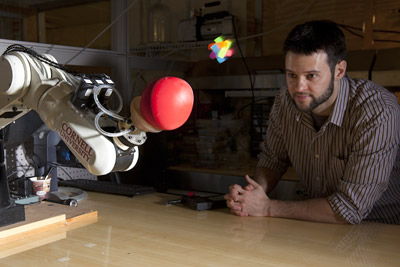Robotic gripper can throw darts, balls - with no arm motion
By Anne Ju

The Cornell-developed robotic gripper that already boasts Internet fame and imitation has evolved: Now, it can throw things, without swinging an arm, by using air pressure to launch objects forward.
Researchers in the lab of Hod Lipson, associate professor of mechanical and aerospace engineering and of computing and information science, described their robotic gripper's new capabilities online Jan. 30 in IEEE Transactions on Robotics, to appear later in print.
But it's really best to see it in action. John Amend, the graduate student who works on the gripper as part of his Ph.D. thesis, has the prototype gripper attached to a robotic arm in the Cornell Creative Machines Lab. When programmed, it can pick up and toss objects at different speeds and trajectories. A video shows the gripper tossing balls, sorting tools into bins and hitting a dartboard bull's-eye.
The gripper, a latex balloon filled with coffee grounds, bears down and hardens, due to evacuated air, around whatever object is being gripped and, when the air pressure is reversed, the object is released. Depending on the rate of the air pressurization, the object can be launched into the air.
"With the original version, resetting the gripper between grips was slow when we tried to pick up several things in a row," Amend said. "We decided to include positively pressurized air to try to solve that problem, and the shooting ability was an unexpected benefit."
The science behind the gripper is called the jamming transition, a physical phenomenon in which particles, in this case, coffee grounds, act like a fluid when loosely packed, and interlock like gears to solidify when compressed. Collaborators on the project at the University of Chicago, led by Heinrich Jaeger, study the physics of this jamming transition.
This simple idea that has created such a fuss among robotics enthusiasts has lots of commercial potential, but many questions remain, Lipson noted.
For example -- how well would this gripper hold up after 100,000 uses? How precisely can the timing of the grip and release be controlled? How do the coffee grounds (or other granular material) change over the lifetime of the gripper?
"It sounds like a very simple thing, this jamming mechanism, but people spend careers trying to understand how spheres interact, let alone randomly shaped particles," Lipson said.
Robotic grippers are not new; the typical design has taken inspiration from the human hand, and elegant ones, although complex and expensive, do exist. And although throwing has been demonstrated by other robotic hands, the researchers point out that the momentum for throwing is typically provided by the arm motion, whereas the Cornell gripper simply releases the object at the optimum rate, with no involvement of the arm.
Integrating the proved principle of a universal gripper into more complex systems, for example, robotics hands with grippers for fingers, may be next, Lipson said.
Amend said he couldn't have guessed how popular the gripper would become, from high school robotics competitors imitating the design to people online writing instructional guides on building the perfect gripper.
"It's not something we expected at all," he said.
The research is supported by the Defense Advanced Research Projects Agency.
Media Contact
Get Cornell news delivered right to your inbox.
Subscribe